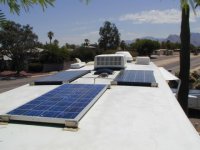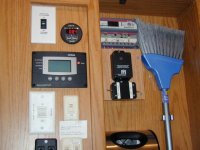Ok, here’s the scoop on my system.
Inverter is a Xantrex rs2000
http://www.xantrex.com/web/id/40/p/1/pt/29/product.asp I think I paid something near 1000.00 for it. Do be sure to get an inverter that has a built in charger. You can put near 100 amps per hour back into the batteries, depending on how big your battery bank is. If I were doing my system over, I would look for something with less fixed overhead (5 amps for the Xantrex) , and really I don’t think you need the full sine wave inverter for most things. We actually have two inverters, but that’s another story.
We have 4 6v Trojans 60-70 bucks ea.
You need a controller, so you don’t overcharge the batteries. 300.00 or so.
We have 3 Kyocera 125-130 panels about 600.00 ea.
http://store.solar-electric.com/kc-120.html
Then you need about a hundred pounds of wire. You’ll be surprised at how much and how large the wire needs to be. The bad news is its ez to spend a hundred bucks on a little bit of wire.
Now for your usage it all depends on how much stuff you need to run. I have attached a spreadsheet of some amp draws that I did a couple of years ago on my small rv. The individual amps are about the same, but with the new rig use more. The calcs are pretty simple amps in and amps out. Its like a glass of water, you put some in and take some out.
With the 4 Trojans, you have about 440 amp hours to use, but only plan on about 220 as a max usage, if you want your batteries to last forever. With our 3 panels the max we normally see is about 20 amps output. So on a 10 hr solar day I would expect something under 180 amp hours per day to be put back in the batteries. But in the winter months shorter days, it could easily drop down to 50-75 amp hours back to the batteries per day.
Also one of the most important goodies is the amp hour meter, we have a link 10, but I don’t think its available anymore. But there are others available. It lets you monitor the batteries like a fuel tank, very helpful item to understand what’s going on.
One other problem, once you get all set up, you run the risk of becoming a solar snob. You just hate to see someone come nearby with a generator, or god forbid a construction generator.




